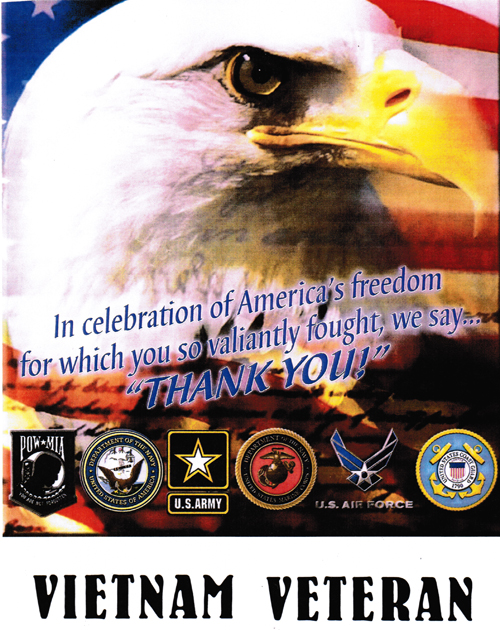By the time many of you read this, “The Parade That Never Was” will have already occurred. (It is scheduled for 10:00 a.m., Saturday, October 13, downtown Victoria.) The parade begins at the library (Main and Commercial Sts.), goes past City Hall, turns right in front of St. Mary’s Catholic Church on Church St. and then right again on Bridge. It will end approximately at Bridge and Power. The Dolphin plans to have coverage of the parade in our next issue.
We salute the Warrior’s Weekend Board, sponsors of this event, and we wish to add our thanks to these heretofore unrecognized servicemen by honoring those we know of in this special issue of Dolphin Talk. A number of veterans have responded to our request for their photo for this issue and we have also included those who were previously honored in our special Veterans issue on November 12, 2010.
Everyone of “Baby Boomer” age or older remembers the Vietnam War era as a time of change and conflict in our country and how media reports caused many to disavow the War and our soldiers who fought it. These brave heroes bore the brunt of the ill will generated at that time and many, if not most, received, not a “welcome home”, but a cold and spiteful reception from their fellow countrymen. We hope Saturday’s parade, and our small part in presenting this special issue, finally make them feel the pride of service and the honor they deserve.
The Vietnam War
The Vietnam War was a long, costly armed conflict that pitted the communist regime of North Vietnam and its southern allies, known as the Viet Cong, against South Vietnam and its principal ally, the United States. The war began in 1954 (though conflict in the region stretched back to the mid-1940s), after the rise to power of Ho Chi Minh and his communist Viet Minh party in North Vietnam, and continued against the backdrop of an intense Cold War between two global superpowers: the United States and the Soviet Union. More than 3 million people (including 58,000 Americans) were killed in the Vietnam War; more than half were Vietnamese civilians. By 1969, at the peak of U.S. involvement in the war, more than 500,000 U.S. military personnel were involved in the Vietnam conflict. Growing opposition to the war in the United States led to bitter divisions among Americans, both before and after President Richard Nixon ordered the withdrawal of U.S. forces in 1973. In 1975, communist forces seized control of Saigon, ending the Vietnam War, and the country was unified as the Socialist Republic of Vietnam the following year.
Vietnam War Protests:
The movement against U.S. involvement in the Vietnam War began small–among peace activists and leftist intellectuals on college campuses–but gained national prominence in 1965, after the United States began bombing North Vietnam in earnest. Anti-war marches and other protests, such as the ones organized by Students for a Democratic Society (SDS), attracted a widening base of support over the next three years, peaking in early 1968 after the successful Tet Offensive by North Vietnamese troops proved that war’s end was nowhere in sight.
-History.com
Coming Home:
The stories of Vietnam veterans coming home reveal how bitterly divided the country was. Some veterans were belittled by people who referred to them as ‘baby-killers’ or ‘crazy Vietnam vets.’ It was common that even family and friends did not want to talk about the war with them, and when they did, they brought it up in a very negative manner. Some veterans feel they were stereotyped during and after the war, especially the stereotype concerning drugs and alcohol. Many veterans experienced guilt and other hardships after returning home from Vietnam. However, some veterans feel that the Vietnam veteran’s image has improved throughout the years because the veterans took care of each other (i.e. building the Wall).
The Wall:
The Vietnam Veterans Memorial (The Wall) is comprised of 142 panels and is 493 feet long. It honors U.S. service members of the U.S. armed forces who fought in the Vietnam War, service members who died in service in Vietnam/South East Asia, and those service members who were unaccounted for (Missing In Action) during the War. The main part of the memorial, which was completed in 1982, is in Constitution Gardens adjacent to the National Mall, just northeast of the Lincoln Memorial. The memorial is maintained by the U.S. National Park Service, and receives around 3 million visitors each year.
The Wall was completed at a cost of $8.4 million ($18.7 million in today’s money). All funds were raised privately. There were no Federal funds used. There are currently 58,272 names on the wall, including 333 additions since 1982.
The Wall That Heals:
On Veterans Day 1996, the Vietnam Veterans Memorial Fund unveiled a half-scale replica of the Vietnam Veterans Memorial in Washington, D.C., designed to travel to communities throughout the United States. Since its dedication, The Wall That Heals has visited more than 350 cities and towns throughout the nation, spreading the Memorial’s healing legacy to millions.
The Wall That Heals was brought to Port O’Connor in late November of 2001. (See article “The Incredible Wall” at in this issue.)

